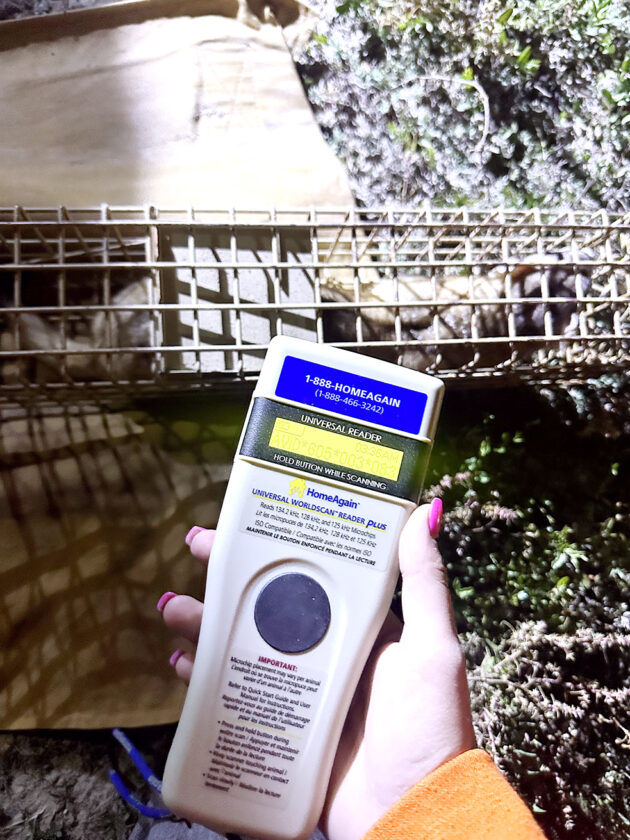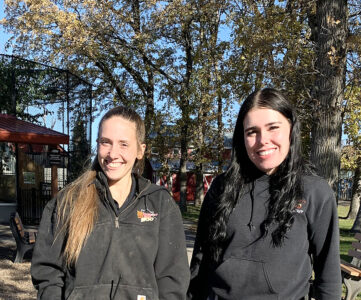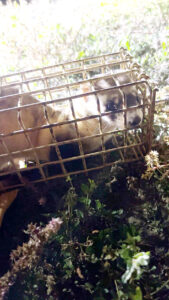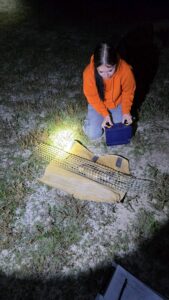Minot zookeepers help with black-footed ferrets’ future

Eloise Ogden/MDN ABOVE: Quinn Iffert, left, and Ellie Johnson, zookeepers at Roosevelt Park in Minot, took part in a program to spotlight black-footed ferrets to count the numbers of these animals and monitor those living in Badlands National Park in South Dakota.
When Quinn Iffert and Ellie Johnson, zookeepers at Roosevelt Park Zoo in Minot, took part in a project to spotlight black-footed ferrets in Badlands National Park in South Dakota, biopsy cells from the ferret they captured were sent to the Smithsonian Institute to make stem cells for future research.
Iffert and Johnson, with several others from the Minot zoo, including a Greater Minot Zoological Society Board member, traveled to the park in southwest South Dakota to take part in the project in October to spotlight the animals to count their numbers and monitor those living there.The project involves trapping ferrets in wire traps, allowing the ferrets to be evaluated.
Chelsea Mihalick, zoo curator, said participation in the spotlighting project is by invitation only from Prairie Wildlife Research.
Prairie Wildlife Research is a nonprofit organization based in Stevens Point, Wisconsin, committed to preserving prairie species, focusing on the endangered black-footed ferret and black-tailed prairie dog, according to organization information. The organization partners with agencies, universities and landowners.
Iffert, the Minot zoo’s primate and hoof stock zookeeper, and Johnson, the outreach zookeeper, were fortunate during their spotlighting to capture a ferret with a microchip in Badlands National Park.

A black-footed ferret in Badlands National Park in South Dakota is shown inside a wire trap. The traps allow handling the ferrets in a safe manner and perform necessary evaluations on them with ease.
The microchip allows identifying the animals and determining health trends, or if it’s a new kit/individual, the microchip allows researchers to see how the population is growing, Dr. Logan Wood, Roosevelt Park Zoo director, said.
Black-footed ferrets, one of the most endangered animals in North America, are classified as endangered by the International Union for Conservation of Nature (IUCN).
The ferrets are nocturnal, so spotlighting is done during the nighttime hours, starting around 10 or 10:30 p.m. and continuing until about 6 a.m., according to Iffert and Johnson.
The first night, Johnson said, they saw two ferrets but did not catch any and the second night they caught one and it was the only one they saw. The third and fourth night they saw one ferret each night but didn’t catch any.
When they went out to search for the ferrets, Johnson said they used a large spotlight on their vehicle to spotlight the animals. The ferrets’ eyes reflect a greenish color, which confirms it is a ferret and not another animal. Once a ferret is spotted, they hold the spotlight on it and try to drive up to it, then they put down a place maker and also a trap.

A scanner is used to detect if a black-footed ferret has a microchip.
Johnson explained the trap, replicating the ferrets’ tunnels, has a blanket around it to keep the ferret warm. Usually the ferret will run up into the trap and the trap closes behind them. Usually, she said, traps are checked about every hour to see if a ferret is in it.
They said they used a scanner to tell if the animal had a microchip in it.
Iffert said the Smithsonian Institute is making stem cells, so with the ferret that they caught, they used the microchip reader to see if Dr.Travis Livieri already had inserted a microchip in the ferret. Livieri is executive director of Prairie Wildlife Research.
Iffert said the ferret they caught already had its vaccines but Livieri took an ear biopsy of the ferret to send to the Smithsonian Institute.
“That’s what they’re going to make stem cells out of, so we basically helped catch an immortal ferret. His stem cells will be at the Smithsonian forever,” she said.

Submitted Photo Ellie Johnson, a zookeeper at Roosevelt Park in Minot, kneels by a wire trap that is placed over black-footed ferret dens to capture ferrets in Badlands National Park in southwest South Dakota. Once the ferret goes into the trap a certain distance, the trap closes behind it.
The Smithsonian’s National Zoo and Conservation Biology Institute is doing the stem cell work.
Livieri said when the team from Roosevelt Park Zoo helped with the black-footed ferret spotlighting surveys, “We took biopsy samples from some captured ferrets that will be preserved as frozen cells at the Smithsonian. This is part of a collaborative project between University of Florida, Smithsonian and Prairie Wildlife Research.”
He said one of the black-footed ferrets, adult male #22-125, captured by the Roosevelt Park Zoo crew, was sampled in early October. He said nine black-footed ferrets were sampled at that time and plans are to get additional samples in the future.
“These biopsies, a small piece of ear tissue about the same diameter as a pencil lead, are grown into pluripotent stem cells that can be used for future genetic research as well as genetic restoration (such as cloning),” Livieri said.
“We are certainly grateful for the support of our partners at RPZoo,” Livieri added.
Iffert and Johnson said they enjoyed taking part in the spotlighting project, and they feel what they learned from the spotlighting project helps them with their work at the Minot zoo. They also noted the Minot zoo has a black-footed ferret named Carnelian.
- Eloise Ogden/MDN ABOVE: Quinn Iffert, left, and Ellie Johnson, zookeepers at Roosevelt Park in Minot, took part in a program to spotlight black-footed ferrets to count the numbers of these animals and monitor those living in Badlands National Park in South Dakota.
- A black-footed ferret in Badlands National Park in South Dakota is shown inside a wire trap. The traps allow handling the ferrets in a safe manner and perform necessary evaluations on them with ease.
- A scanner is used to detect if a black-footed ferret has a microchip.
- Submitted Photo Ellie Johnson, a zookeeper at Roosevelt Park in Minot, kneels by a wire trap that is placed over black-footed ferret dens to capture ferrets in Badlands National Park in southwest South Dakota. Once the ferret goes into the trap a certain distance, the trap closes behind it.





